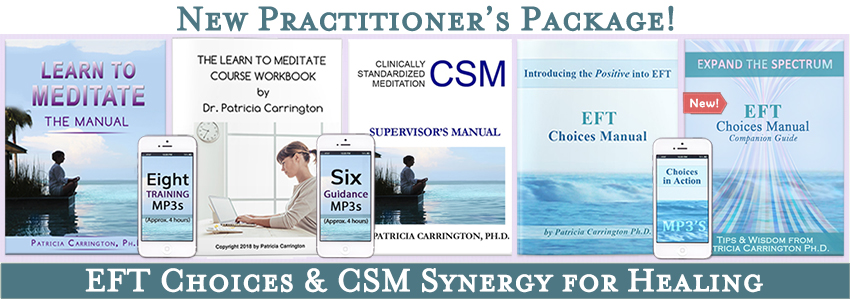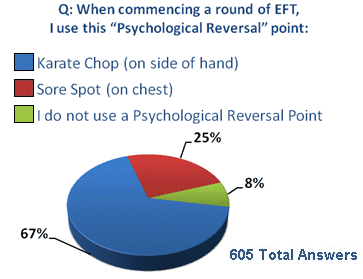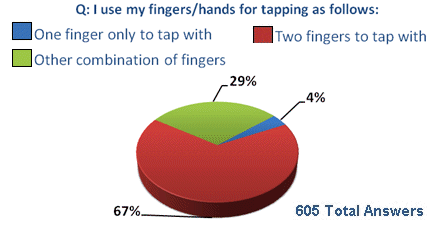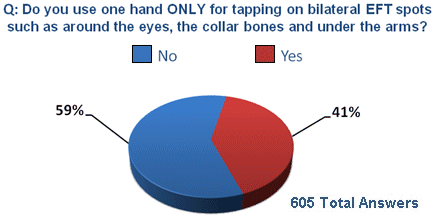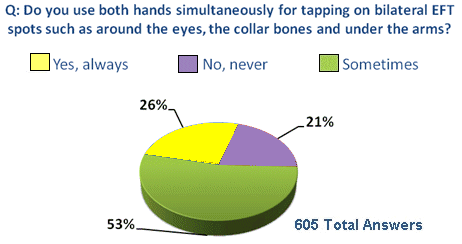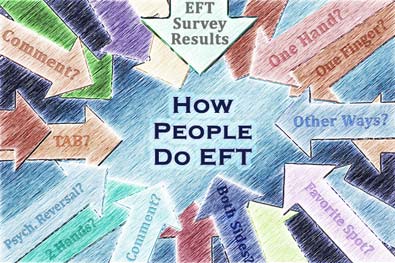 Some years ago, we conducted a research survey asking how people do EFT Tapping, in which over 600 people responded.
Some years ago, we conducted a research survey asking how people do EFT Tapping, in which over 600 people responded.
Comments by Dr. Pat on What the Tapping Points Survey Showed
I am frankly amazed at how many of our readers completed the survey, and how they did this with such care, sincerity, and intelligence. Six hundred and five people participated in the survey before it was closed down after 10 days. More would surely have participated if we had kept it going longer.
This response is not only excellent because of the number of people who took part in the survey but because of the generous way in which they shared their detailed subjective comments about their use of the EFT tapping points.
(Initially, there were eight questions in the survey, however, two of them were related to an earlier form of EFT that is basically obsolete, today. They have been omitted from this updated report.)
Each survey question required the respondent to check one of several possible short answers, and then provide optional comments. I had thought that our respondents wouldn’t add many detailed comments, because that is time consuming, but in fact almost all of the participants commented on one or more questions, providing us with hundreds of detailed comments, which gave us extremely valuable information about EFT. It is a veritable treasure trove of EFT information.
At the time, I went over these comments with the help of enthusiastic family members and friends who sat at our dining table for days, cutting and pasting the comments from the printouts and placing them into meaningful categories in order to draw useful conclusions.
Below is important information from some of the quantitative findings. These give us a broad overview, which is extremely useful in itself. They are shown below as pie charts, so that you can see the results at a glance, along with some observations and comments from the respondents.
(UPDATED: Initially, only the numbers were reported here, due to the high number of comments by the respondents. Recently, the original data was discovered, reviewed, summarized and added to the original report (See below). The second, more extensive survey on How People Use EFT for some specific issues was conducted shortly after this survey was conducted and those results have now been published.)
EFT Survey Questions
Question: I have a favorite tapping spot that works so well for me that I use it instead of the full tapping sequence.
Close to half of the respondents said that at least occasionally they use a favorite tapping spot in place of the whole sequence.
he most commonly indicated favorites:
- Collarbone/chest area
- Karate Chop spot
- Under eye
- Under nose
- Top of Head
Some comments from respondents:
“Sometimes the spot reveals itself, and changes according to what I’m working on.”
“Full routine is so easy and swift, why not do it all.”
“Sometimes I just use one of the eye points.”
“My under eye points (I use both hands…) are my all time favorites. I get instant relief, relaxation and it feels like I’ve been luxuriating at a spa for hours.”
“Just one favorite point for tapping and mine is under the nose.”
“I get cramps at night and I found the three eye tapping points will stop them without using anything else.”
“Mostly it is the top of head spot, but it can as well be any other.”
Question: When commencing a round of EFT, I use this “Psychological Reversal” point:
As you can see, the karate chop spot is used much more often than the sore spot as a psychological reversal point.
Note: When one’s “energy polarities” are temporarily reversed with regard to a particular issue, you may feel “stuck,” because the energy system may be “reversed” and the energetic polarities within your body are temporarily opposite to what they should be in order for EFT to work. This is much like having a battery in backwards in a flashlight, so the positive and negative poles of the battery are contacting the opposite poles from those that they should be contacting. When this occurs, the flashlight won’t work until the batteries are turned around.
Typically, a set-up statement related to Reversal or Resistance is created and repeated, while tapping on the Karate Chop spot, the Collarbone/chest area, or other points.
Some Respondent’s Comments:
“I seem to feel more comfortable using the karate chop than the chest. I can’t seem to feel confident that I tap on the right spot when tapping on chest.”
“I prefer the karate chop. It is less noticeable.”
“I use both karate chop and sore spot for reversal.”
“I use Sore Spot for a “Turbo Boost”!
“For most applications, the KC point seems sufficient. Interestingly, if I am clearing a deeper, or longer-standing issue, the sore spot seems to get it moving faster.”
“When I notice tail-enders creeping in, I prefer to change tactic and use the top of head.”
“When I was a Head Teacher, I got anxious children to alternate between karate chop and under eye /cheekbone points–it always worked”
“Only if progress is modest (or no progress) I use the sore spots. Otherwise the KC point seems to do just fine.”
“I use either of these points. I also have used KC alternated with the under nose point to correct reversal.”
“Sometime (I) cross my arms across my chest to get both sore spots.”
Also, out of 133 comments, some of the participants indicated that they could not locate the sore spot, didn’t know about a psychological reversal point, did not know what a PR is, or chose not to use it.
Question: I use the “Touch and Breath” Method of EFT
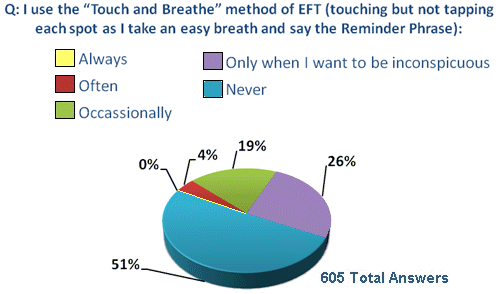
The Touch and Breathe (TAB) method (that uses no tapping, just a light touch) is used at least occasionally by almost half the people who responded.
Some Comments by Respondents:
“I use it with exceptionally sensitive clients. I also use it when I’m feeling jangled energetically. Otherwise I feel I get more impact, personally, with tapping.”
“Great for relaxation.”
“Sometimes I use this with my children if they don’t want to tap. I need to get a tapping bear!”
“I use this method only when I go to bed.”
“Recently, when I was sick, this worked very well. I had also been using it for several friends who seemed to resist tapping in general- they felt it was just too much…”
“(I) use in public and when relaxing”
“Some clients take to TAB. High sensitivity, injury are reasons.”
“I use this a lot when there is heavy stuff coming up. I don’t need to repeat any phrase. It’s gentle and settling.”
“Have tried it and found it to be less satisfying to me.”
Question: I Use My Fingers/Hands for Tapping as Follows:
While most respondents say they use two fingers to tap with, a number reported using other combinations of fingers, attesting to the remarkable individuality of EFT practice.
Comments by Respondents Regarding Other Combination of Fingers:
“I typically use the four fingers of each hand on each spot, down each side.”
“I use all of my fingers to tap with.”
“I use the first three fingers of both hands.”
“Usually all four fingers of each hand as I like “double” sided tapping down the body.”
“Three fingers to tap on the Karate point; two fingers to tap on the eye brow points and three fingers to tap under the eye.”
“I can use the first three fingers, or even all the first four. My idea is to cover as many parts as possible. I also know that the fingers are energy points….all of them are as important so I use them.”
“…if I’m doing both underarms then I use the back of the first 4 fingers – monkey-like.”
“I am a massage practitioner and I do massage and EFT on horses. I use long strokes with the side of my hands, strokes or taps with all 4 fingers for some appropriate areas such as the top of the head…”
“Because we are trying to hit the meridian points, I tell my clients to gently use as many fingers as possible in order to increase the statistical odds of hitting the right places even when they are tapping rapidly.”
“3 fingers usually, unless point has restricted access e.g. eyebrow.”
Question: Do You Use One Hand, Only, or Both Hands for Bilateral Tapping?
Via the combination of these two questions, most people use one hand only for bilateral tapping spots such as those around the eyes, collarbone points etc. I do this, as it feels natural to me, but many people reported that they will switch to two hands at the bilateral points and then back again to one hand for the others. Then again, others used varying methods.
Some Comments from Respondents:
“I am not consistent – sometimes I use one hand and sometimes I use 2”
“Sometimes if I feel really distressed and am crying or very angry, I will tap points on each side of the head/face/UA with the bilateral hand/fingers at the same time, instead of doing just one side or the other and switching back and forth.”
“I use one hand most of the time, but find it works best if I cross over occasionally.”
“Right hand, 2 fingers. However, I alternate tapping on each side of my face/body.”
“Use my dominant hand and one side of the body. If I get tired will swap hands and tap the other side of my body.”
“Haven’t found much difference if I use both hands.”
“I use one hand at a time, but I sometimes use the right & sometimes the left — I think it makes me feel more balanced to not always tap only on one side.”
“I usually do one hand – occasionally two if SUDS is not changing.”
“Most of the time I tap with one hand. But when I am really frustrated I use both hands. It feels like I am doubling the energy and vibration I send and evoke in my body.”
“I usually use two hands around the eyes and one for the collar bones and under the arm.”
“I never thought to do it this way, although I just realized that I DO rub BOTH my sore spots while repeating my set-up phrase and always have begun my sessions this way.”
“I try to use them both about the same amount but seem to wind up using my right hand more — I am left-handed.”
“For me, I almost “always” use an alternating rhythm of both hands, so I can do both sides and reach more spots. When I use one hand, it feels lopsided to me.”
In summary, one of the most striking things that this survey revealed is the extraordinary innovation of EFT users. The survey reveals a great deal about these individual responses to EFT. People feel very strongly about their own variations of EFT and often find that other variations just don’t seem to do the same thing for them at all. Fascinating…
Related Articles:
How People Use EFT Survey Results
Do I always have to tap for EFT to be effective?
By Patricia Carrington Ph. D., EFT Master



